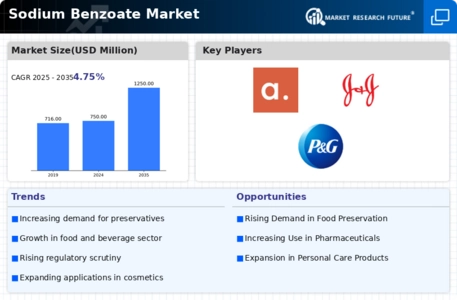Market Trends
Key Emerging Trends in the Sodium Benzoate Market
The market dynamics of sodium benzoate have undergone significant changes, influenced by various factors ranging from increasing demand in the food and beverage industry to regulatory considerations. Sodium benzoate, a widely used preservative, has become a key ingredient in preserving the freshness and extending the shelf life of a variety of products. One of the primary drivers of the sodium benzoate market is its role in preventing the growth of bacteria, yeast, and mold in food and beverage products, thereby ensuring their safety and quality.
The food and beverage industry's growing reliance on sodium benzoate can be attributed to the rising demand for processed and convenience foods. As consumers seek products with longer shelf life and stability, food manufacturers turn to preservatives like sodium benzoate to meet these requirements. The versatility of sodium benzoate as an effective preservative across a wide range of products, including soft drinks, sauces, and baked goods, contributes to its widespread adoption in the industry.
Regulatory considerations also play a crucial role in shaping the market dynamics of sodium benzoate. Government regulations and food safety standards influence the permissible levels of preservatives in food and beverages. Manufacturers must adhere to these regulations to ensure the safety of their products. The regulatory landscape evolves, impacting the production, formulation, and usage of sodium benzoate. Manufacturers need to stay informed about these changes to remain compliant and maintain market presence.
The global sodium benzoate market is further influenced by consumer trends and preferences, particularly the increasing demand for natural and clean-label products. As consumers become more health-conscious and aware of the ingredients in their food, there is a growing preference for natural preservatives over synthetic alternatives. This has led to the development of natural preservatives and, in turn, has posed a challenge to the sodium benzoate market. Manufacturers are responding to this trend by exploring and introducing alternatives or developing blends that combine sodium benzoate with natural preservatives.
Price fluctuations of raw materials, particularly benzoic acid, impact the cost of production and, subsequently, the market dynamics of sodium benzoate. The availability and pricing of benzoic acid, a key precursor in sodium benzoate production, are influenced by factors such as raw material sourcing, geopolitical events, and market demand. These fluctuations can affect the overall pricing strategy of sodium benzoate manufacturers and, in turn, impact their competitiveness in the market.
Global trade dynamics also contribute to the sodium benzoate market's evolution. As the food and beverage industry becomes more interconnected globally, manufacturers often source ingredients from different regions. Factors such as international trade agreements, tariffs, and geopolitical events can impact the availability and cost of sodium benzoate, affecting market dynamics on a broader scale. Manufacturers need to navigate these complexities to maintain a stable supply chain and remain competitive in the global market.






Leave a Comment